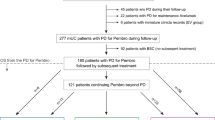Abstract
This phase II study was designed to determine the objective response rate and 6-month progression free survival of adult patients with recurrent supratentorial anaplastic glioma when treated with the immune modulator, polyinosinic-polycytidylic acid stabilized with polylysine and carboxymethylcellulose (poly-ICLC). This was an open-labeled, single arm phase II study. Patients were treated with poly-ICLC alone. Patients may have had treatment for no more than two prior relapses. Treatment with poly-ICLC continued until tumor progression. Fifty five patients were enrolled in the study. Ten were ineligible after central review of pathology. Eleven percent of patients (5 of 45) had a radiographic response. Time to progression was known for 39 patients and 6 remain on treatment. The estimated 6-month progression free survival was 24%. The median survival time was 43 weeks. Poly-ICLC was well tolerated, but there was no improvement in 6-month progression free survival compared to historical database nor was there an encouraging objective radiographic response rate. Based on this study, poly-ICLC does not improve 6moPFS in patients with recurrent anaplastic gliomas but may be worth further study in combination with agents such as temozolomide.

Similar content being viewed by others
References
Stupp R et al (2005) Radiotherapy plus concomitant and adjuvant temozolomide for glioblastoma. N Engl J Med 352(10):987–996. doi:10.1056/NEJMoa043330
Stupp R et al (2007) Anaplastic astrocytoma in adults. Crit Rev Oncol Hematol 63(1):72–80. doi:10.1016/j.critrevonc.2007.03.003
Walker MD et al (1980) Randomized comparisons of radiotherapy and nitrosoureas for the treatment of malignant glioma after surgery. N Engl J Med 303(23):1323–1329
Walker MD et al (1978) Evaluation of BCNU and/or radiotherapy in the treatment of anaplastic gliomas. A cooperative clinical trial. J Neurosurg 49(3):333–343
Stewart LA (2002) Chemotherapy in adult high-grade glioma: a systematic review and meta-analysis of individual patient data from 12 randomised trials. Lancet 359(9311):1011–1018. doi:10.1016/S0140-6736(02)08091-1
Prados MD et al (1999) Procarbazine, lomustine, and vincristine (PCV) chemotherapy for anaplastic astrocytoma: a retrospective review of radiation therapy oncology group protocols comparing survival with carmustine or PCV adjuvant chemotherapy. J Clin Oncol 17(11):3389–3395
Levin VA et al (1990) Superiority of post-radiotherapy adjuvant chemotherapy with CCNU, procarbazine, and vincristine (PCV) over BCNU for anaplastic gliomas: NCOG 6G61 final report. Int J Radiat Oncol Biol Phys 18(2):321–324
Yung WK et al (1999) Multicenter phase II trial of temozolomide in patients with anaplastic astrocytoma or anaplastic oligoastrocytoma at first relapse. Temodal Brain Tumor Group. J Clin Oncol 17(9):2762–2771
Droller MJ (1987) Immunotherapy of metastatic renal cell carcinoma with polyinosinic-polycytidylic acid. J Urol 137(2):202–206
Hawkins MJ, Levin M, Borden EC (1985) An Eastern Cooperative Oncology Group phase I-II pilot study of polyriboinosinic-polyribocytidylic acid poly-L-lysine complex in patients with metastatic malignant melanoma. J Biol Response Mod 4(6):664–668
Krown SE et al (1985) Phase I trials of poly(I,C) complexes in advanced cancer. J Biol Response Mod 4(6):640–649
Nakamura O et al (1982) Phase I-II trials of poly(ICLC) in malignant brain tumor patients. J Interferon Res 2(1):1–4
Rettenmaier MA, Berman ML, DiSaia PJ (1986) Treatment of advanced ovarian cancer with polyinosinic-polycytidylic lysine carboxymethylcellulose [poly(ICLC)]. Gynecol Oncol 24(3):359–361. doi:10.1016/0090-8258(86)90313-6
Theriault RL et al (1986) Evaluation of polyinosinic-polycytidylic and poly-L-lysine in metastatic breast cancer. Cancer Treat Rep 70(11):1341–1342
Talmadge JE et al (1985) Hyporesponsiveness to augmentation of murine natural killer cell activity in different anatomical compartments by multiple injections of various immunomodulators including recombinant interferons and interleukin 2. J Immunol 135(4):2483–2491
Ewel CH et al (1992) Polyinosinic-polycytidylic acid complexed with poly-L-lysine and carboxymethylcellulose in combination with interleukin 2 in patients with cancer: clinical and immunological effects. Cancer Res 52(11):3005–3010
Black KL et al (1992) Inflammatory leukocytes associated with increased immunosuppression by glioblastoma. J Neurosurg 77(1):120–126
Talmadge JE et al (1985) Immunomodulatory effects in mice of polyinosinic-polycytidylic acid complexed with poly-L-lysine and carboxymethylcellulose. Cancer Res 45(3):1058–1065
Levy HB (1985) Historical overview of the use of polynucleotides in cancer. J Biol Response Mod 4(5):475–480
Levy HB, Levine AS (1981) Antitumor effects of interferon and poly ICLC, and their possible utility as anti-neoplastic agents in man. Tex Rep Biol Med 41:653–662
Matsumoto M, Seya T (2008) TLR3: interferon induction by double-stranded RNA including poly(I:C). Adv Drug Deliv Rev 60(7):805–812
Kim H et al (2008) Double-stranded RNA mediates interferon regulatory factor 3 activation and interleukin-6 production by engaging Toll-like receptor 3 in human brain astrocytes. Immunology 124(4):480–488
Balachandran S, Barber GN (2007) PKR in innate immunity, cancer, and viral oncolysis. Methods Mol Biol 383:277–301. doi:10.1007/978-1-59745-335-6_18
Salazar AM et al (1996) Long-term treatment of malignant gliomas with intramuscularly administered polyinosinic-polycytidylic acid stabilized with polylysine and carboxymethylcellulose: an open pilot study. Neurosurgery 38(6):1096–1103. doi:10.1097/00006123-199606000-00006 (discussion 1103–1104)
Zhu X et al (2007) Toll like receptor-3 ligand poly-ICLC promotes the efficacy of peripheral vaccinations with tumor antigen-derived peptide epitopes in murine CNS tumor models. J Transl Med 5:10. doi:10.1186/1479-5876-5-10
Levin VA et al (1995) Radiation therapy and bromodeoxyuridine chemotherapy followed by procarbazine, lomustine, and vincristine for the treatment of anaplastic gliomas. Int J Radiat Oncol Biol Phys 32(1):75–83. doi:10.1016/0360-3016(94)00488-7
Macdonald DR et al (1990) Response criteria for phase II studies of supratentorial malignant glioma. J Clin Oncol 8(7):1277–1280
Wong ET et al (1999) Outcomes and prognostic factors in recurrent glioma patients enrolled onto phase II clinical trials. J Clin Oncol 17(8):2572–2578
Butowski N et al (2008) A phase II clinical trial of poly-ICLC with radiation for adult patients with newly diagnosed supratentorial glioblastoma: a North American Brain Tumor Consortium (NABTC01-05). doi:10.1007/s11060-008-9693-3
Lamborn KR et al (2008) Progression-free survival: an important end point in evaluating therapy for recurrent high-grade gliomas. Neuro Oncol 10(2):162–170. doi:10.1215/15228517-2007-062
Acknowledgement
We would like to thank Oncovir Inc. for their support of this study.
Author information
Authors and Affiliations
Corresponding author
Rights and permissions
About this article
Cite this article
Butowski, N., Lamborn, K.R., Lee, B.L. et al. A North American brain tumor consortium phase II study of poly-ICLC for adult patients with recurrent anaplastic gliomas. J Neurooncol 91, 183–189 (2009). https://doi.org/10.1007/s11060-008-9705-3
Received:
Accepted:
Published:
Issue Date:
DOI: https://doi.org/10.1007/s11060-008-9705-3




